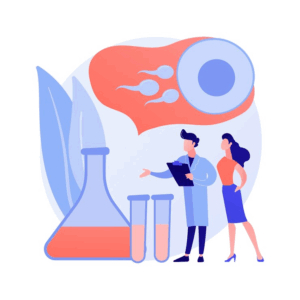
Is Prolistem Effective for Azoospermia? A Complete Fertility Guide
Introduction Is Prolistem effective for azoospermia? This question is vital for many men struggling with infertility due to azoospermia — a condition characterized by the

Non-Obstructive Azoospermia Success. A diagnosis of non-obstructive azoospermia (NOA) can feel overwhelming. However, advances in medical science and reproductive technology have created new possibilities for men with this condition. While NOA refers to a complete lack of sperm in the semen due to production issues rather than blockages, success is increasingly achievable.
In this blog, we will explore how the non-obstructive azoospermia success rate continues to rise thanks to breakthrough treatments, lifestyle strategies, and patient resilience. Whether you’re newly diagnosed or already exploring treatment options, this guide is for you.
Non-obstructive azoospermia occurs when the testicles do not produce sperm, or produce so few that none appear in the ejaculate. Unlike obstructive azoospermia, there is no physical blockage. Instead, the issue lies in sperm production itself.
Genetic defects (e.g., Klinefelter syndrome)
Hormonal imbalances (low testosterone, high FSH)
Testicular damage (from trauma, radiation, or infections)
Varicoceles (enlarged veins affecting testicular temperature)
Undescended testicles
Understanding the cause is crucial, as it shapes your treatment pathway and impacts your overall non-obstructive azoospermia success potential.
Diagnosis typically begins with a semen analysis. If two or more tests confirm a complete lack of sperm, doctors move forward with further testing.
Hormonal Tests: To assess FSH, LH, testosterone, and prolactin levels.
Genetic Screening: Identifies Y-chromosome microdeletions or other anomalies.
Scrotal Ultrasound: Detects varicoceles or testicular masses.
Testicular Biopsy: Confirms the presence or absence of sperm-producing cells.
These steps help fertility specialists develop a customized strategy that maximizes your chances of success.
Although NOA cannot always be “cured” in the traditional sense, many men still father biological children with help. The key lies in identifying pockets of sperm production and retrieving those sperm for use in assisted reproductive technologies (ART).
Even if sperm do not appear in semen, they may still exist in the testicles, offering hope for a successful retrieval and conception.
This procedure is considered the gold standard. A urologist uses a high-powered microscope to locate areas in the testes where sperm may still be produced.
Success Rate: Between 30% and 60%
Best For: Men with NOA undergoing IVF with ICSI
For men with hormonal deficiencies, medications such as clomiphene citrate, hCG, or anastrozole can stimulate natural sperm production over time.
Timeframe: Typically takes 3–6 months
Outcome: In some cases, sperm reappear in the ejaculate
If sperm is retrieved via Micro-TESE, it can be used to fertilize an egg via intracytoplasmic sperm injection (ICSI). This method bypasses the need for natural fertilization.
Success Depends On Egg quality, lab expertise, and underlying male fertility issues
This advanced diagnostic procedure maps out where sperm-producing cells may be found within the testicles. Consequently, it improves retrieval accuracy during Micro-TESE.
Rafiq, a 32-year-old man from Bangladesh, was devastated when diagnosed with NOA. However, his doctor recommended hormone therapy followed by Micro-TESE. After six months, a few sperm were retrieved and used for IVF-ICSI. Today, Rafiq and his wife are proud parents.
“At first, I lost hope. But my doctor guided me patiently, and eventually, we were blessed with a baby.”
Jason had a history of undescended testicles and was told he might never have children. Nevertheless, Micro-TESE led to a successful retrieval. With ICSI, he and his wife conceived on the second IVF attempt.
These stories serve as powerful reminders that non-obstructive azoospermia success is attainable.
While natural remedies don’t replace medical treatment, they often support overall reproductive health.
✅ Quit smoking and alcohol
✅ Eat antioxidant-rich foods: berries, nuts, leafy greens
✅ Take supplements: Zinc, Vitamin E, CoQ10, L-Carnitine
✅ Manage stress through yoga, therapy, or meditation
✅ Exercise moderately
✅ Avoid excessive heat: Hot baths and saunas can impair sperm health
Consistency matters. Over time, these changes can enhance the success of other treatments.
Azoospermia doesn’t just affect the man; it impacts the couple. The psychological stress associated with infertility is real, and often overlooked.
Join Support Groups: Online forums and local communities
Seek Therapy: Individual or couples counseling helps process emotions
Communicate Openly: Honest conversations strengthen relationships
Many couples find that shared emotional resilience plays a big role in their ultimate success.
To increase your odds, consider the following expert tips:
📌 Act early: Fertility declines with age and time
📌 Select experienced fertility centers for Micro-TESE and IVF
📌 Freeze sperm if retrieved: You may not want to repeat surgery
📌 Stay consistent with hormonal medications
📌 Adopt a fertility-friendly diet
These proactive steps can make a measurable difference.
Yes. Many men with NOA become fathers through treatments like Micro-TESE combined with IVF and ICSI.
In rare cases, if all options fail, couples may consider donor sperm or adoption. However, it’s worth seeking multiple opinions before giving up.
Usually, Micro-TESE is a one-time procedure. But some men may undergo additional attempts depending on the initial outcome.
Non-obstructive azoospermia was once seen as the end of the road for biological parenthood. Thankfully, today’s medical breakthroughs are proving that narrative wrong.
From hormone therapy to Micro-TESE and ICSI, couples have more options than ever. And while not every story succeeds, the number that do is steadily rising.
If you’re facing this condition, remember: you’re not alone, and success is truly possible.

Introduction Is Prolistem effective for azoospermia? This question is vital for many men struggling with infertility due to azoospermia — a condition characterized by the

Prolistem for non-obstructive azoospermia is gaining attention in the world of male fertility treatment. For men diagnosed with NOA—a condition where the body fails to
Prolistem, a patented formula, has not been evaluated by the Food and Drug Administration. This product is not intended to diagnose, treat, cure, or prevent any disease.
PROLISTEM® is a Patented Formula
Copyright © 2025 Prolistem®